User Research
Competitive Analysis
User Profiles (Personas)
Digital Strategy
Web Design
Front-end Development
Timeline : 6 months
Tools : FIGMA, Illustrator, Photoshop, WordPress, CSS, HTML, PHP
Contact me about this project.
World’s Children wanted a website that would reach a wider audience and encourage more user interaction. They weren’t sure how to achieve these goals. However, through research and testing the priorities became clear.
We focused on improving navigation, an easy check-out process, and storytelling to achieve these goals.


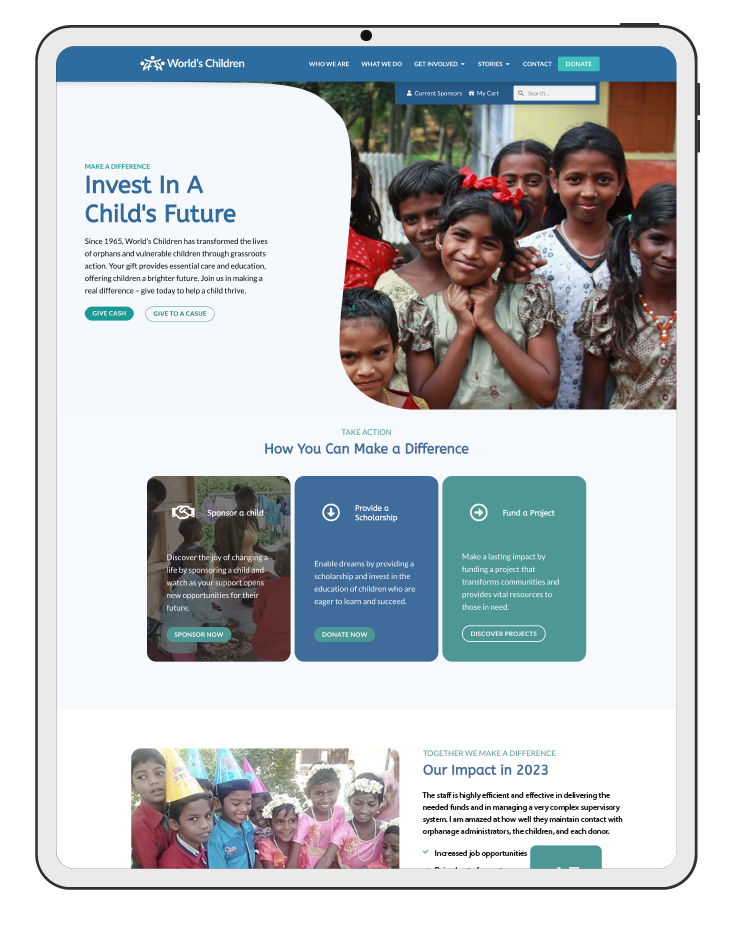
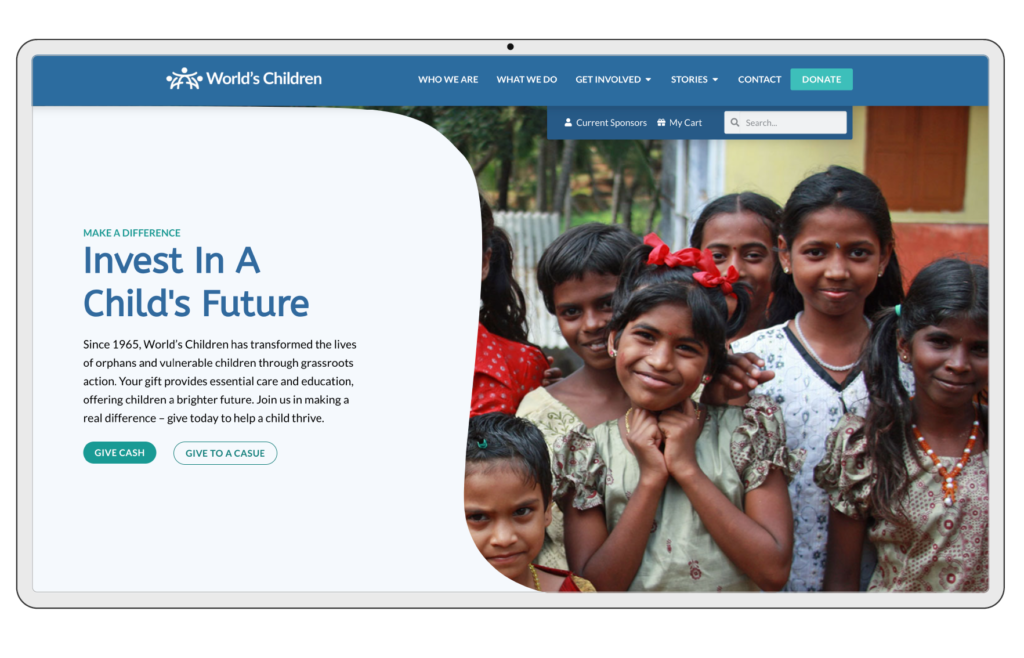

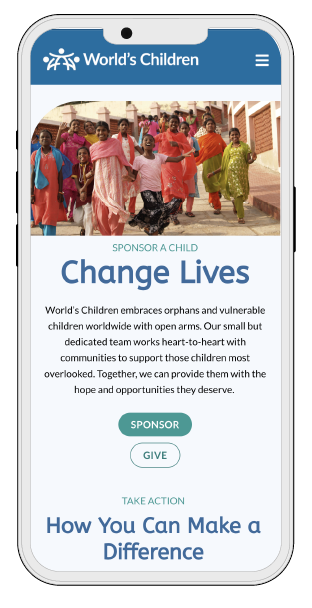
For the best viewing experience, this case study must be viewed on a desktop device.
In the meantime, you can explore this case study’s overview for a quick glimpse of my work.
A key challenge was understanding World’s Children’s unique approach to fundraising. Unlike traditional nonprofits, they generate revenue through a combination of individual, group, and project-based initiatives. This comprehensive model significantly influenced design strategy, guiding us towards innovative and creative solutions.

Research for this project included user research (observational, quantitative, and qualitative) and competitive analysis.
For user personas, business goals, and a problem-solution matrix head over to the Define section.
Ideation for this project includes sitemap, task flow, low-fidelity wireframes, and responsive wireframes.
Finally, I design and incorporate a mood board, UI kit, and high-fidelity wireframes into a high-fidelity prototype.
We started by getting to know World’s Children’s audience intimately through observational, quantitative, and qualitative research.
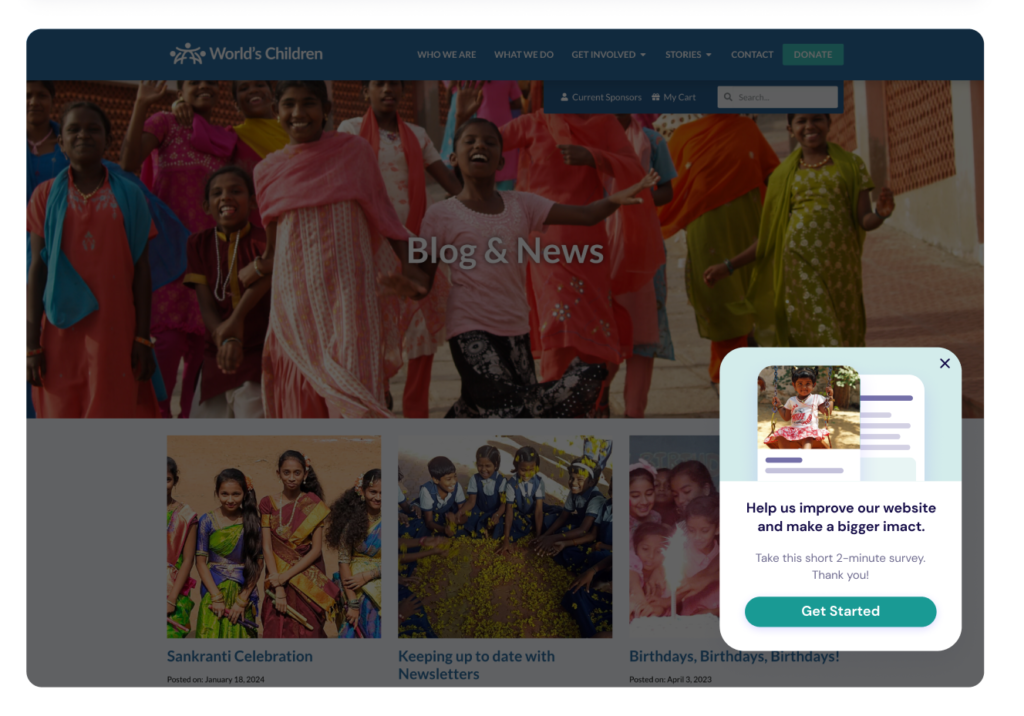
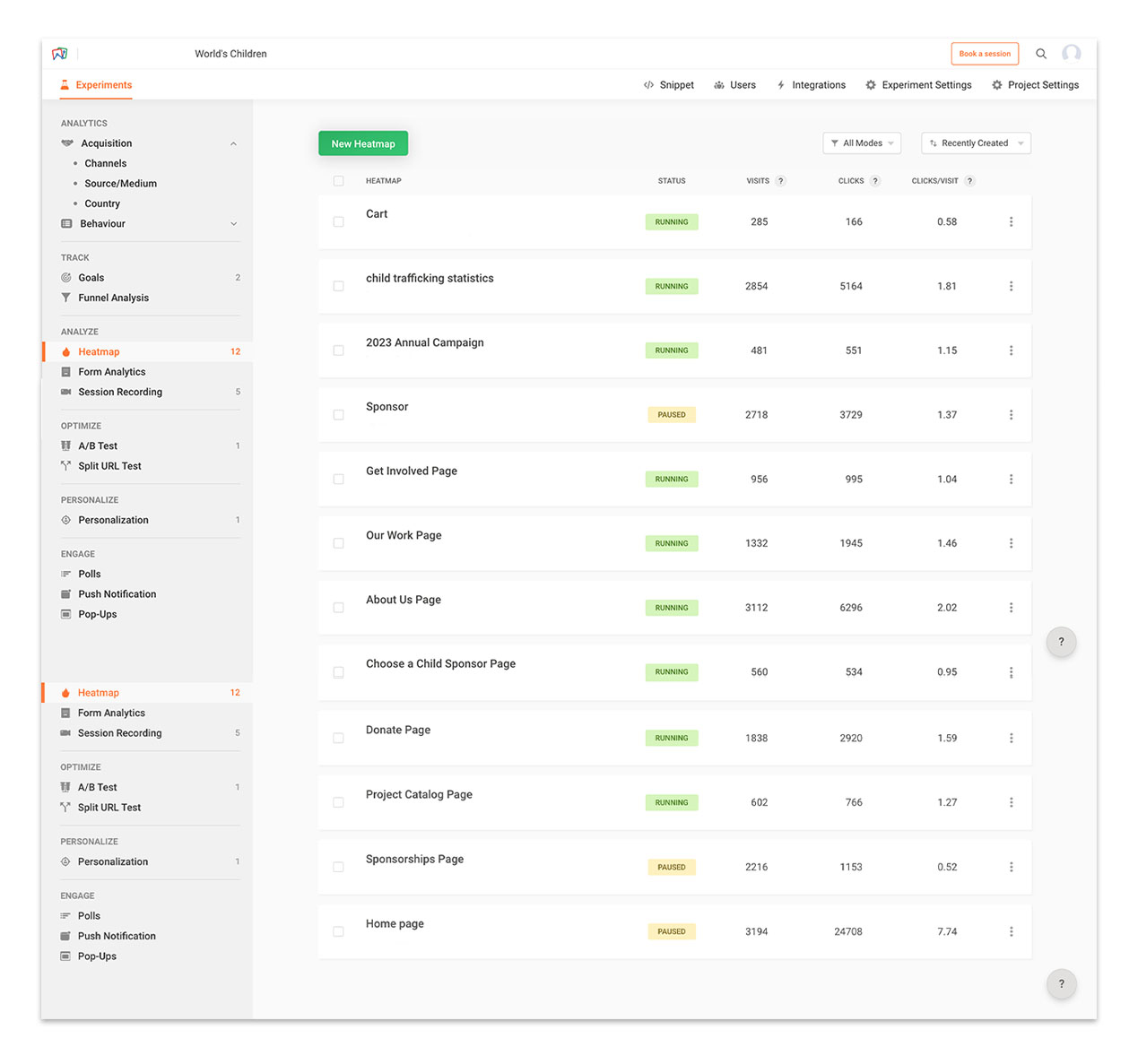
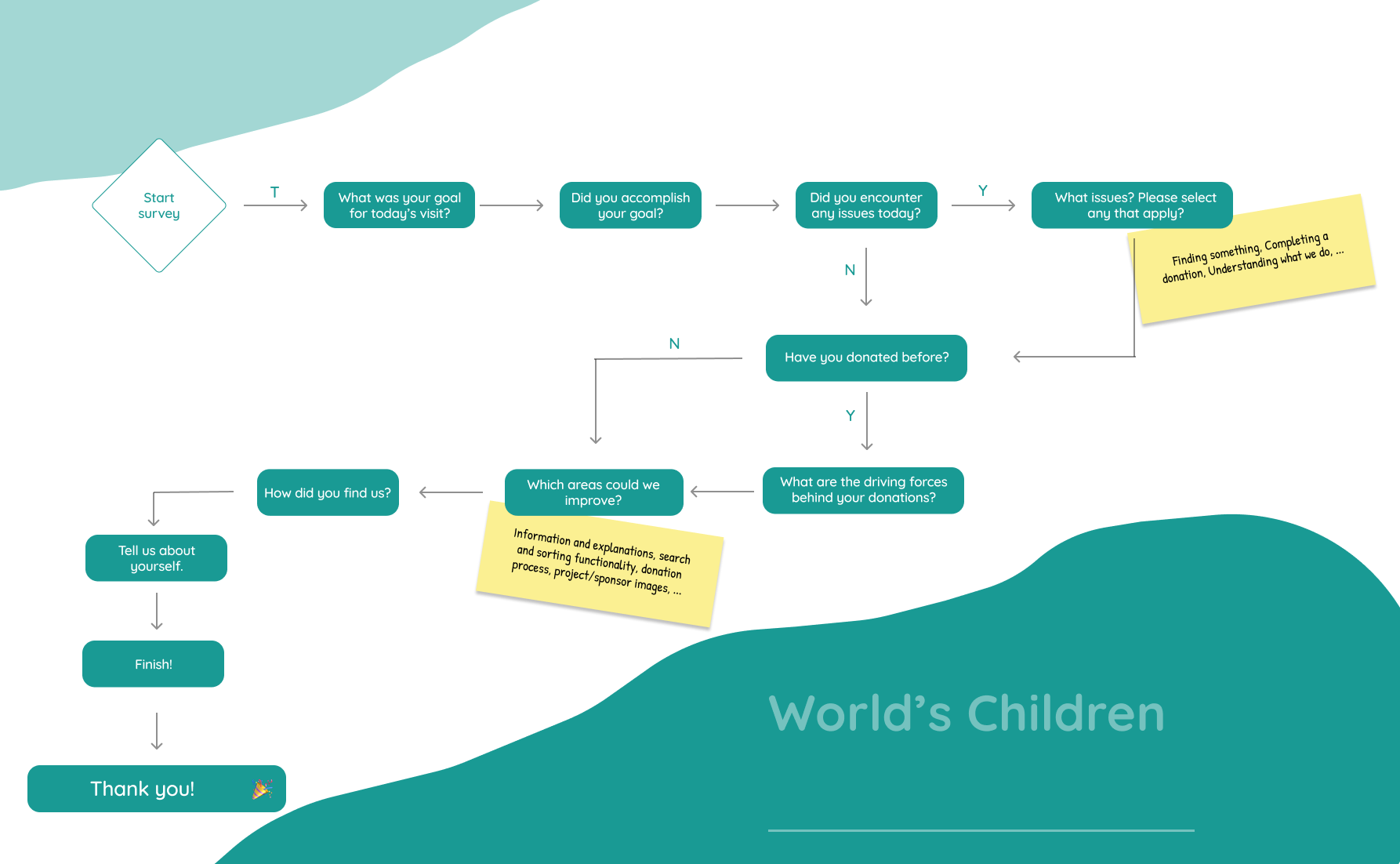


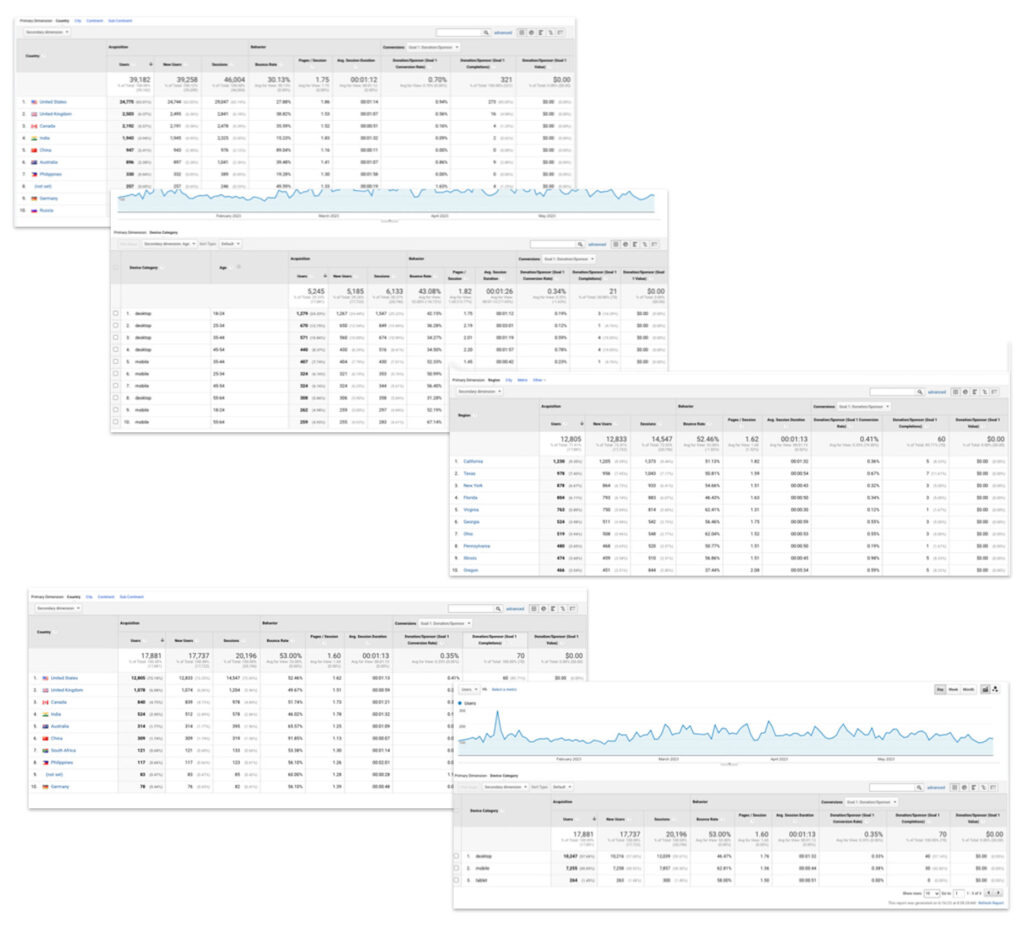
Content and Interest: The data revealed a strong user interest in content that explores the regional impact of human trafficking. This suggests a desire to understand the specific challenges faced by different areas.
Optimize Navigation for Sponsorships: Prioritize placement and clarity of content-specific “Sponsor” or “Sponsorships” within the main navigation to cater to user interest.
Streamline User Journey: Based on minimal clicks on “Gift Catalog” and “Donate” across all pages, consider removing these options from the main navigation because they lead to separate landing pages and lead to confusion.
Add Partnership Opportunities: A dedicated portal for partners would streamline inquiries and application processes as well as offer donation history and personalized communications, facilitating a deeper relationship.
Focus on Core Pages: Retain “About Us,” “Our Work,” and “Get Involved” in the main navigation as they received significant user engagement.
Enhance User Experience: The low engagement with “Items Cart” suggests a potential issue with the shopping cart functionality or user clarity. Investigate and improve this section.
Enrich Navigation (Optional): Consider adding a “Contact” option to the main navigation, potentially drawing inspiration from its placement in the footer.
Submenu Options: Explore the possibility of implementing submenus within the main navigation for options like “Choose a Child” under a “Sponsorships” umbrella. This can help users find specific sponsorship options with ease.
By implementing these recommendations, their user engagement increased. Users could find the information they needed within 1-2 clicks and also enjoyed browsing.
I cannot emphasize curiosity enough. Curiosity is the key to progress. Until we truly understand the issues, the solutions will remain hidden.
By understanding their competitors’ user experience and approach to sponsorships, I identified opportunities to differentiate World’s Children.
Enhanced Navigation: Implement clear and intuitive navigation to simplify finding information.
Search & Sort: Enable users to quickly locate specific details with search and sorting functionalities.
Mobile Responsiveness: Ensure a seamless experience across all devices with a responsive layout
Accessibility: Adjust color schemes to meet accessibility standards for wider user inclusion.
Financial Transparency: Maintain prominent access to financial information for user trust.
Credibility Builders: Showcase partner logos, regulatory certifications, and testimonials to establish credibility.
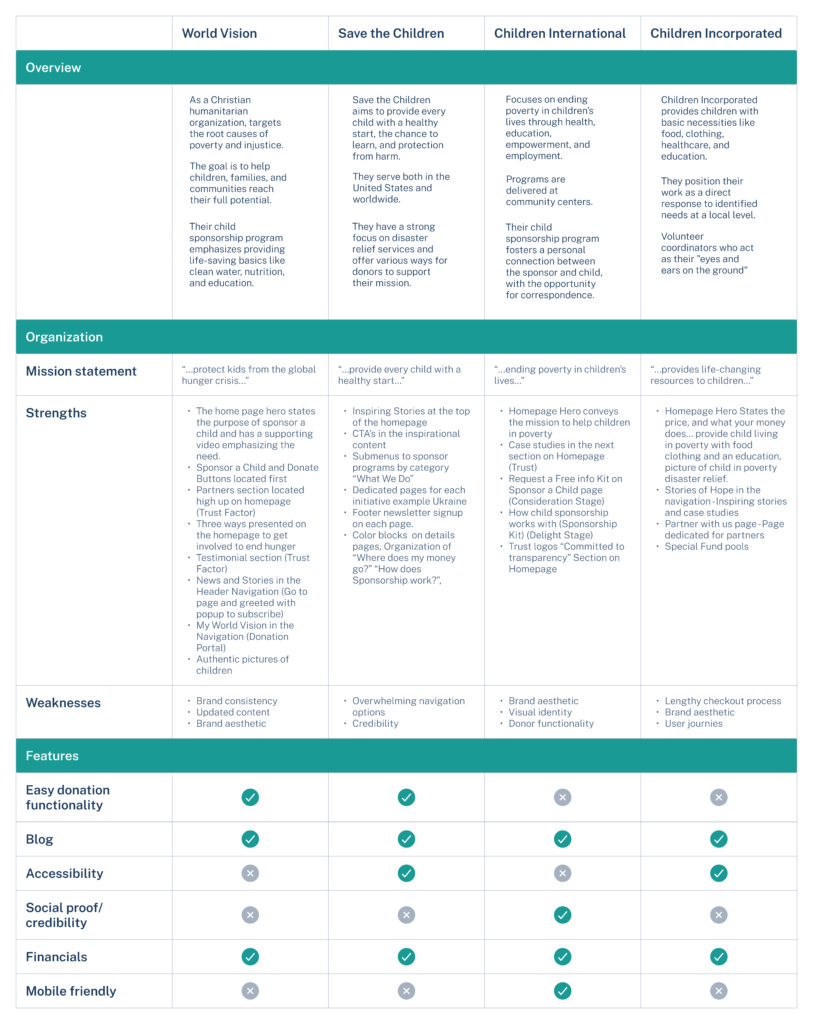
I cannot emphasize curiosity enough. Curiosity is the key to progress. Until we truly understand the issues, the solutions will remain hidden.
Foster a shared understanding of the user audiences and project objectives amongst all stakeholders.
Click on the arrow icon under each persona to view specifics.
Despite their differences, personas all valued availability of information on donation methods, transparency in allocation of funds, and donation impact.
I don't just see data points, I see people. By weaving together research and analytics, I paint a clear picture of the who, what, and why behind every click and interaction.
To measure the success of your website changes, we’ll track their impact on key organizational benchmarks. Here’s an overview of these metrics based on 2022 data (percentages are totals calculated for the entire year):
$587.87
$628
$383.43
$425
0.70%
0.74%
52%
60%
14.7%
18%
Tracking Changes and Optimization:
By monitoring these metrics before and after website changes, we can assess the impact of those changes on donor acquisition, engagement, and overall contribution to your mission. This data will guide future website optimizations to achieve your business goals.
Lorem ipsum dolor sit amet, consectetur adipiscing elit. Ut elit tellus, luctus nec ullamcorper mattis, pulvinar dapibus leo.

Evaluating and prioritizing ideas based on their potential impact, feasibility, and alignment with user needs and business goals.
Meeting the Needs of Users
Based on the priorities, challenges, and goals identified, this map was created to directly addresses them. Each category will contain multiple subpages, offering users a clear and organized path to find the information they need.
I strategically utilized card-based sections within the wireframes. This modular approach ensured the content would adapt seamlessly across different devices, from desktops to mobile screens. The card-based structure not only facilitated responsiveness but also proved to be a highly efficient way to organize and prioritize content.
Wireframes are the blueprints of user experience. They allow us to experiment with layouts and functionality before investing time and resources in aesthetics. It's like sketching the foundation of a house before laying the bricks - crucial for creating a user experience that's both functional and delightful.
Branding is more than just a logo and colors; it's the essence of your organization. As a UX designer, I translate this essence into an experience where users can connect with your personality on a human level.
When prototyping I strive to bring my design ideas to life and start testing them with users.
For the mood board, I took a sensory-based approach, focusing on sight, touch, and smell. These senses evoked feelings of trustworthiness, inspiration, inclusiveness, and dedication, key brand attributes I wanted to capture.
The goal was to elicit a visceral response, creating a deep bond between donors and the brand.
These high-fidelity wireframes included interactions which allowed me to test my design assumptions with real users early in the development process and iterate.
Quick Links: Research Critical Assemblage Ideation Prototype



This project follows a clear four-stage approach, designed to deliver a website that not only looks great but actively supports World’s Children’s goals.
World’s Children desired an updated website with intuitive navigation, elevated branding, and responsive design with an easy check-out process.
CLIENT NAME : World’s Children
PROJECT TYPE : UX/UI Design, Branding Development
TIMELINE : 6 months
TOOLS : FIGMA, Illustrator, Photoshop, WordPress, CSS, HTML, PHP
ROLES : UX Researcher, UI Designer, Developer
This project includes four out of the five design thinking framework phases.
The Research phase includes the competitive analysis and user (observational, quantitative, and qualitative) research.
The Define phase includes the user personas, business goals, and a problem-solution matrix.
The Ideation phase includes the sitemap, task flow, low-fidelity wireframes, and responsive wireframes.
And finally, the Prototype phase which includes the mood board, UI kit, high-fidelity wireframes, and high-fidelity prototype.
The team started by getting to know World's Children's audience intimately through observational, quantitative, and qualitative research.
Leveraging insights from Stage 1, I participated in crafting personas, a problem-solution matrix, and an outline of business goals to inform the design of a website that surpasses the current one.
In this stage, we develop the foundation for their website, which includes a sitemap, task flow, and wireframes.
I developed an enhanced brand identity and interface kit, hi-fi wireframes, and, finally, the prototype.
Create an intuitive and responsive navigation system that's easy to use on any device.
Create a smooth and user-friendly experience that encourages them to become heroes for children.
Capture attention with inspiring content and a clean, uncluttered design.
Showcase the stories of the children they help in a captivating way. Let donors see the difference they can make.
To view this case study in its entirety, revisit here on a desktop device.

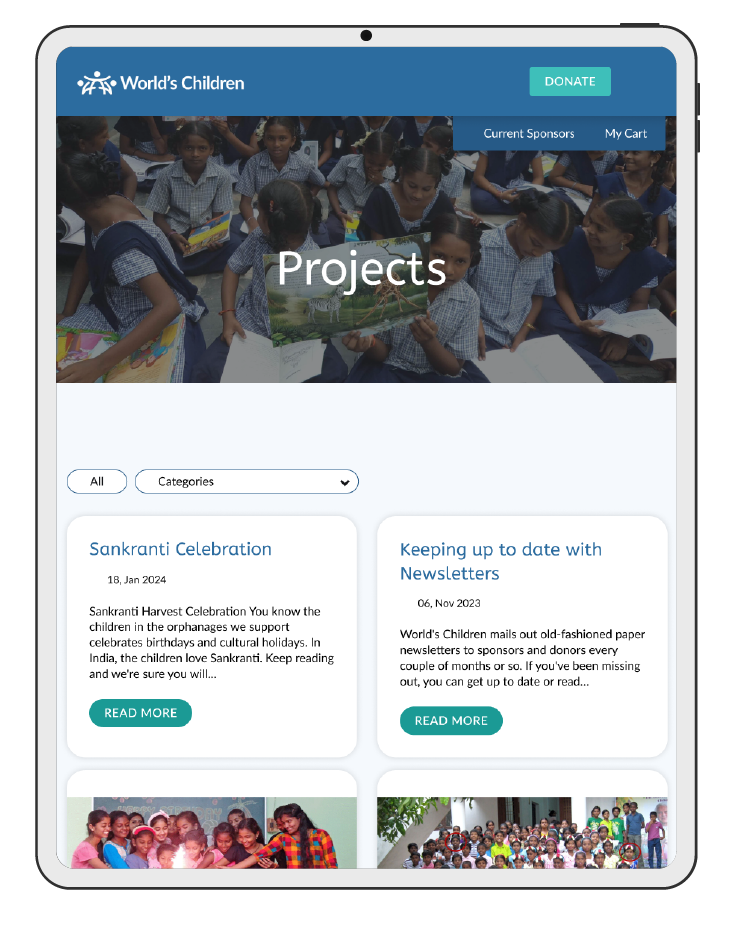
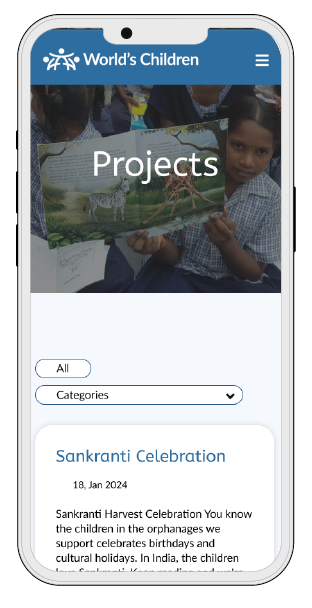
By combining the hierarchical structure for navigation with the flexibility of a database model for content organization, their website benefits from:
World’s Children desired to add search and sort capabilities, which take into consideration several forms of post-types.
CLIENT NAME : World’s Children
PROJECT TYPE : UX/UI Design Development
TIMELINE : 1 month
TOOLS : FIGMA, Illustrator, Photoshop, WordPress, CSS
ROLES : UI Designer, Developer
This project includes Ideation and Prototype phases.
The Ideation phase includes the donor task flow, low-fidelity wireframes, and responsive wireframes. The Prototype phase which includes the mood board, UI kit, high-fidelity wireframes, and high-fidelity prototype.
Note: This project leveraged research conducted during our website redesign for this client, ensuring a cohesive and data-driven approach.
In this stage, I brainstorm the foundation for their solution, which includes the donor task flow and wireframes.
Then, I developed hi-fi wireframes, and, finally, the prototype.
To view this case study in its entirety, revisit here on a desktop device.
I’m in the process of adding or updating this project. Come back soon.